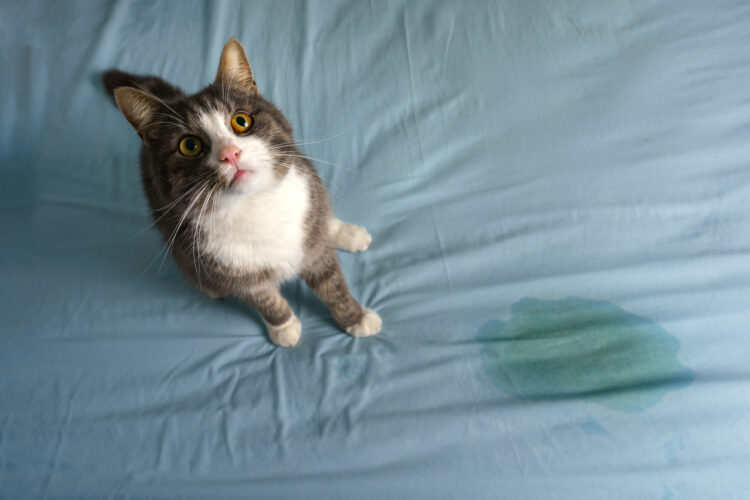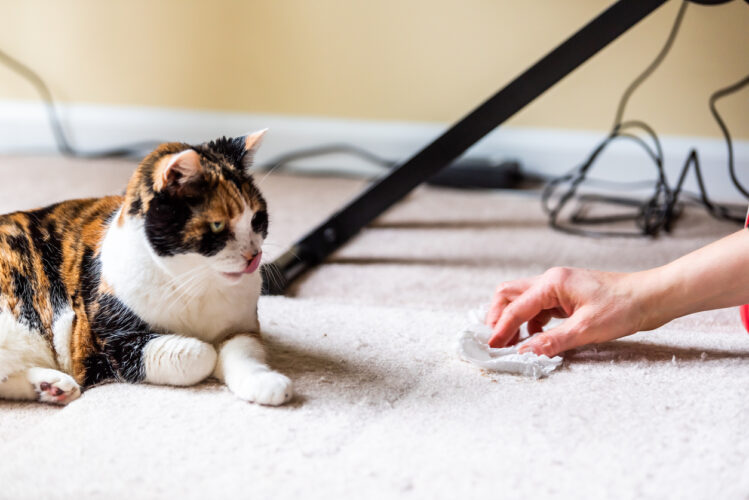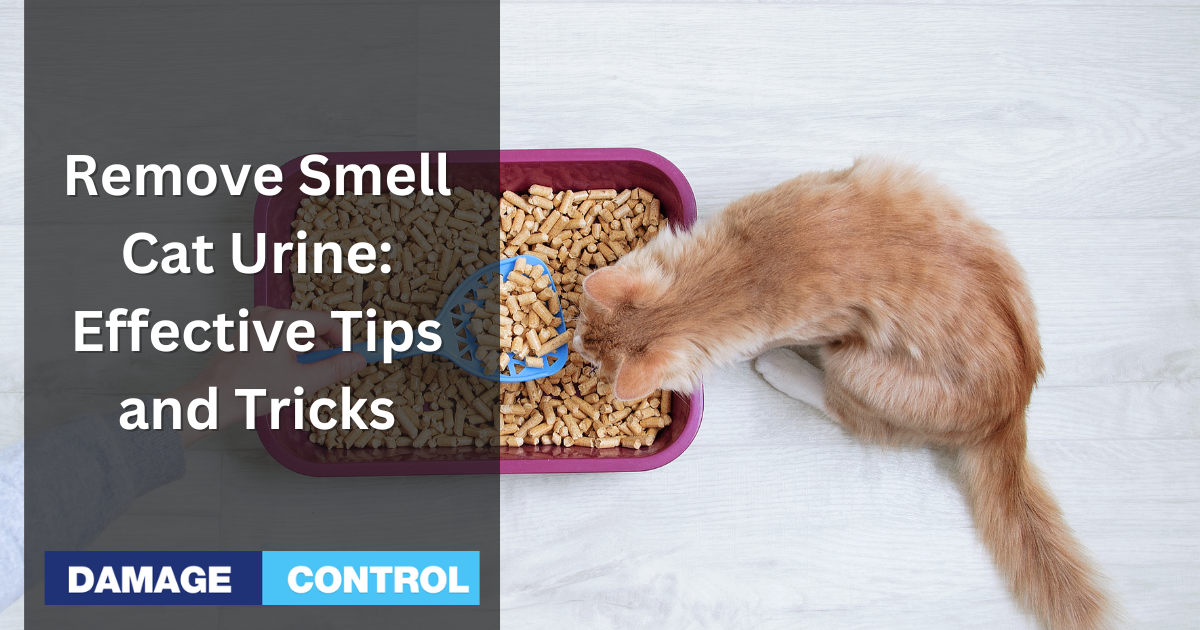Are you struggling to get rid of the smell of cat urine? It can be challenging and frustrating, but don't worry; you're not alone. Many cat owners have faced this problem at some point. The good news is that you can effectively remove the smell of cat urine from your home with the right techniques and products.
One of the most important things to remember when dealing with cat urine is to act fast. The longer the urine sits, the harder it will be to remove the odor. So, if you notice your cat has peed outside of their litter box, it's important to clean it up as soon as possible. This will not only make the task easier but will also help prevent the odor from spreading.
You can use several methods and products to remove the smell of cat urine. From natural remedies like vinegar and baking soda to commercial enzyme cleaners, there are many options. Choosing a safe method for your cat and your home is important. Some products may contain harsh chemicals that can harm your cat or damage your furniture or carpets.
How to Identify the Affected Area
 Image source: istockphoto.com
Image source: istockphoto.comCats are notorious for peeing outside of their litter box, which can cause a strong and unpleasant odor. The first step to removing the smell of cat urine is to identify the affected area. Here are some tips to help you locate the source of the smell:
- Use your nose: The smell of cat urine is strong and distinctive. Follow your nose to locate the area where the smell is the strongest.
- Look for stains: Cat urine leaves behind yellow or brown stains often. Use a black light to help locate the stains, which will glow under ultraviolet light.
- Check the litter box: If your cat is consistently peeing outside of the litter box, it may be a sign that the litter box is dirty or not in a suitable location. Check the litter box to see if it needs to be cleaned or moved to a more private location.
- Observe your cat's behavior: If your cat is consistently peeing in a particular area, it may be a sign that they are marking their territory. Observe your cat's behavior to see if they exhibit other signs of territorial behavior.
Once you have identified the affected area, it's important to clean it thoroughly to remove the smell of cat urine. In the next section, we'll discuss some tips for cleaning cat urine stains and eliminating odors.
Remove Excess Urine
When dealing with cat urine, removing as much of the excess urine as possible before attempting to clean the affected area is important. This will make cleaning more effective and prevent urine from soaking deeper into the carpet or furniture.
Start by blotting the area with paper towels or a clean cloth to remove excess urine. Apply pressure to absorb as much urine as possible, and then repeat with fresh paper towels until you can no longer soak up any more urine. Avoid rubbing the area, as this can spread the urine and make it more difficult to remove.
If the urine has already dried, you can use a wet vacuum to remove the excess urine. This can be especially helpful for larger accidents or areas that are difficult to reach, such as corners or crevices.
Once you've removed as much excess urine as possible, it's time to move on to cleaning the affected area. However, suppose you're dealing with a particularly strong or stubborn odor. In that case, you may consider using an enzymatic cleaner to break down the urine and eliminate the odor at its source.
In summary, to remove excess urine:
- Blot the area with paper towels or a clean cloth
- Apply pressure to absorb as much urine as possible
- Repeat with fresh paper towels until you can no longer soak up any more urine
- Consider using a wet vacuum for larger accidents or hard-to-reach areas
- Act quickly and thoroughly to prevent the odor from becoming permanent.
Apply Enzymatic Cleaner
Once you have located the cat urine stain, it's time to apply an enzymatic cleaner. Enzymatic cleaners are designed to break down the proteins in cat urine, eliminating the stain and odor. Here's how to use an enzymatic cleaner effectively:
- Blot up any excess urine with a clean cloth or paper towel. Avoid rubbing the stain, which can push the urine deeper into the carpet or fabric fibers.
- Apply the enzymatic cleaner to the affected area and saturate the stain completely. Follow the instructions on the cleaner's label for best results.
- Allow the cleaner to sit for at least 10-15 minutes. This gives the enzymes time to break down the proteins in the urine.
- Blot up the cleaner with a clean cloth or paper towel. Avoid rinsing the area with water, which can dilute the cleaner and reduce its effectiveness.
- Repeat the process if necessary. You may need to apply the enzymatic cleaner more than once for stubborn stains or strong odors.
It's important to note that enzymatic cleaners work best when allowed to dry naturally. Avoid using a hairdryer or other heat source to speed up the drying process, as this can set the stain and odor in place.
In addition to enzymatic cleaners, there are other products you can use to eliminate cat urine odor. These include baking soda, white vinegar, and hydrogen peroxide. However, it's important to test these products on a small, inconspicuous area first to ensure they don't damage the fabric or carpet.
Rinse the Area
After blotting up as much of the urine as possible, it's time to rinse the area. Rinsing the area will help remove any remaining urine and cleaning solution residue. This step is crucial in eliminating the smell of cat urine.
To rinse the area, you can use plain water or a solution of water and vinegar. If you use vinegar, mix one part vinegar with two parts water. Pour the solution onto the affected area and let it sit for a few minutes. Then, blot the area with a clean cloth or paper towel until dry.
If the affected area is on a carpet, you can rinse and extract the urine and cleaning solution with a wet vac. Make sure to follow the manufacturer's instructions for using the wet vac.
After rinsing the area, you can use a black light to check for any remaining urine stains. Urine stains will glow under a black light, making them easier to locate. If you find any remaining stains, repeat the cleaning process until the stains are gone.
It's important to note that you should never use ammonia-based cleaners to clean up cat urine. Ammonia smells similar to cat urine and can attract your cat to the area, causing them to continue urinating there.
In addition to rinsing the area, you can use an enzyme cleaner to break down the proteins in the urine. Enzyme cleaners are designed to eliminate the smell of cat urine and can be found at most pet stores.
Allow to Dry
If you catch your cat peeing outside their litter box, you first grab some paper towels and blot up as much urine as possible. You want to remove as much liquid as possible before it can soak into the carpet or furniture.
Once you've blotted up as much urine as possible, it's best to let the area dry before cleaning it. If you try to clean up the urine while it's still wet, you risk spreading it around and worsening the stain. Cleaning up damp cat urine can be messy and difficult, so it's best to let it dry first.
While the urine is drying, keep your cat away from the area. You don't want them to step in the urine and track it around your home. If the urine is on furniture, you may want to cover it with a towel or sheet to prevent your cat from jumping.
Once the urine has dried, you can start cleaning it up. If the urine is on a hard surface like tile or hardwood floors, you can use water and vinegar to clean it up. If the urine is on carpet or upholstery, you'll need a specialized cleaner designed to break down the enzymes in cat urine.
Repeat If Necessary
 Image source: distockphoto.com
Image source: distockphoto.comWhen removing the smell of cat urine, it's important to understand that it may take more than one attempt to eliminate the odor. Even if you think you've successfully removed the smell, it's always a good idea to repeat the process just to be sure.
One reason is that cat urine is notorious for its strong and persistent odor. Even if you've cleaned the affected area thoroughly, the smell may still linger. This is because cat urine contains uric acid, which can crystallize and stick to surfaces, making it difficult to remove.
Another reason to repeat the cleaning process is that cats have a strong sense of smell and may still be able to detect the odor even if you can't. If your cat can still smell the urine, they may be more likely to return to the same spot and urinate again.
To ensure you've eliminated the odor, follow the cleaning process outlined in our previous sections and repeat it if necessary. Here are some tips to help you get the best results:
- Use an enzyme cleaner: Enzyme cleaners are specifically designed to break down the proteins in cat urine, which can help eliminate the odor. Make sure to saturate the affected area thoroughly and let the cleaner sit for the recommended time before blotting it up.
- Don't skimp on the cleaning solution: It's important to use enough cleaning to saturate the affected area thoroughly. If you don't use enough, you may be unable to eliminate the odor.
- Let the area dry completely: After cleaning, let it dry completely before allowing your cat to access it again. This will help prevent moisture from getting trapped in the carpet or furniture, which can lead to mold or mildew growth.
- Use an Ozone Generator: It would take some planning, but ozone eliminates cat urine odors forever by changing the chemical makeup of the odor-causing atoms. It may take two or more 30-minute treatments, but overall, it is the best option for most homeowners.
How to Prevent Future Accidents
If you're dealing with cat urine odor, you know how difficult it can be to eliminate it. The best way to deal with the problem is to prevent it from happening in the first place. Fortunately, there are several things you can do to prevent future accidents.
Use a Litter Box
The most obvious way to prevent cat urine odor is to ensure your cat uses a litter box. Ensure the litter box is in a quiet, private location that is easily accessible to your cat. Keep the litter box clean by scooping it out daily and replacing the litter every week.
Provide Multiple Litter Boxes
If you have more than one cat, it's important to provide each cat with their litter box. Cats are territorial animals and may not want to share a litter box with another cat. Providing multiple litter boxes can also help prevent accidents if one litter box is full or dirty.
Keep Your Cat Hydrated
Make sure your cat has access to plenty of fresh water. Dehydrated cats may be more likely to have accidents. You can encourage your cat to drink more water by providing a water fountain or adding wet food to their diet.
Provide Scratching Posts
Cats may urinate outside the litter box if they are stressed or anxious. Providing scratching posts and other toys can help reduce stress and prevent accidents. Scratching posts can also help prevent your cat from scratching furniture or other household items.
Consider Behavioral Training
If your cat continues to have accidents, consider behavioral training. Positive reinforcement training can help teach your cat to use the litter box and prevent future accidents.
Preventing future accidents is the best way to deal with cat urine odor. Following these tips can keep your home smelling fresh and clean.
Conclusion
To conclude, eliminating the smell of cat urine can be simple with the right methods. Embrace these tips and tricks for a fresh, welcoming home.

